
The University of Ferrara is the main university of the city of Ferrara in the Emilia-Romagna region of northern Italy. In the years prior to the First World War the University of Ferrara, with more than 500 students, was the best attended of the free universities in Italy. Today there are approximately 16,000 students enrolled at the University of Ferrara with nearly 400 degrees granted each year. The teaching staff number 600, including 288 researchers. It is organized into 12 Departments.
Maurelio Scanavini or Scannavini was an Italian painter of the Baroque period, mainly active in Ferrara.

Antonio Randa was an Italian painter of the classicist period, active in Ferrara, Modena, Rovigo, Florence, Comacchio and his native Bologna.

The Roman Catholic Archdiocese of Ferrara-Comacchio has existed since 1986, when the diocese of Comacchio was combined with the historical archdiocese of Ferrara. It is a suffragan of the archdiocese of Bologna.

Tito Vespasiano Strozzi was an Italian Renaissance poet at the Este court of Ferrara, who figures as an interlocutor in Angelo Decembrio's De politia litteraria.
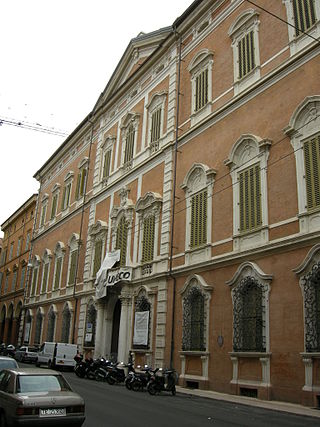
The Palazzo Aldovrandi is a Senatorial palace on Via Galliera 8 in Bologna, built in Rococo style.
Marco Antonio Guarini was an Italian historian and scholar, nephew of Giovanni Battista Guarini and author of the Compendio Historico and of the Famiglie illustri della città di Ferrara.

The Palazzo Torfanini is a Renaissance architecture palace located on Via Galliera 4, in central Bologna. It is located near the Palazzo Aldrovandi. The palace, with typical facade arcades, was commissioned by Bartolomeo Torfanini in 1544.
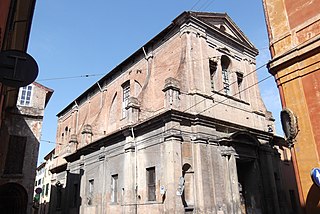
San Barbaziano is a former Mannerist-style, Roman Catholic church located on via Cesare Battisti, 35 in central Bologna, region of Emilia-Romagna, Italy.
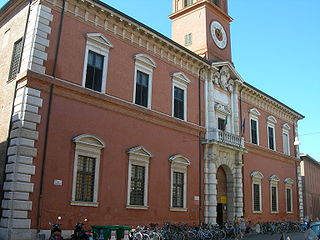
The Palazzo Paradiso is a Renaissance palace located on Via Scienze #17 in the medieval center of Ferrara, region of Emilia-Romagna, Italy. Adjacent to the historic Jewish ghetto of Ferrara, it houses:

Ferrara Charterhouse, of which the present Church of San Cristoforo alla Certosa was previously the monastic church, is a former charterhouse or Carthusian monastery built in Renaissance style, located on Piazza Borso 50 in Ferrara, Region of Emilia-Romagna, Italy. The monastery was suppressed in the time of Napoleon, but the church was reconsecrated in 1813 and remains in use. The site also accommodates a large municipal cemetery, which was established in 1813.
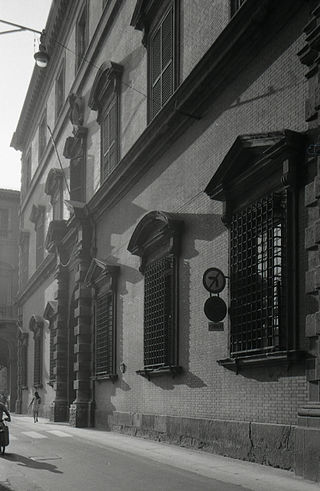
The Palazzo Caprara, also called Palazzo Galliera is a Renaissance-style urban palace located on Via IV Novembre #22 in central Bologna, region of Emilia-Romagna, Italy.

The Palazzo Zambeccari at 11 Via Carbonesi is a Neoclassical urban palace in central Bologna, region of Emilia-Romagna, Italy. It is located diagonal to the facade of San Paolo Maggiore, and in 2015 was home to offices of the Banco Popular di Milano SCRL.
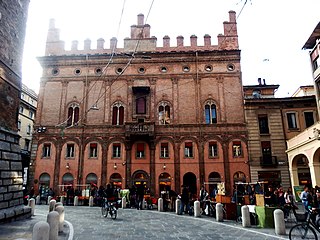
The Palazzo degli Strazzaroli is a Renaissance-style urban palace located at Piazza di Porta Ravegnana #1 in central Bologna, region of Emilia-Romagna, Italy.
The Palazzo Belloni is a palace located on Via de' Gombruti #13 in central Bologna, region of Emilia-Romagna, Italy.
The Palazzo Dondini Ghiselli is a Neoclassical-style palace located on Via Barberia #23, corner with Via Mario Finzi, in central Bologna, region of Emilia-Romagna, Italy.
Santa Maria delle Muratelle, or Santa Maria Annunziata delle Muratelle, is a 17th-century Roman Catholic church located on Via Saragozza #2 in Bologna, region of Emilia Romagna, Italy.
The following is a timeline of the history of the city of Ferrara in the Emilia-Romagna region of Italy.

Palazzo Arese was a 16th century baroque palace and seat of a branch of the House of Arese in Milan, Italy. It was located adjacent to Casa Fontana Silvestri near the Porta Orientale. The palazzo was demolished in 1943 following damage sustained during the bombing of Milan in World War II.
Girolamo Baruffaldi was an Italian historian who wrote a biography of artists active in Ferrara.













